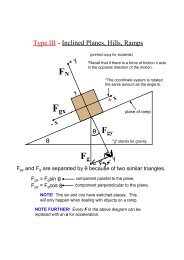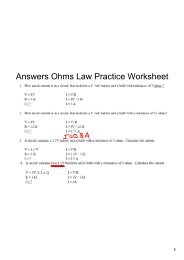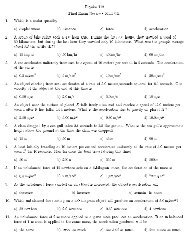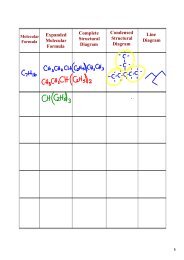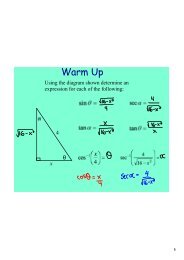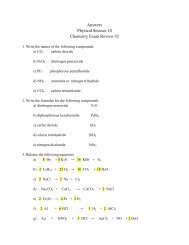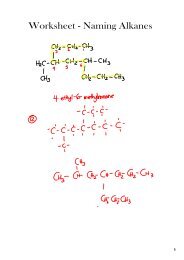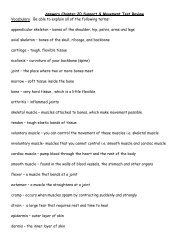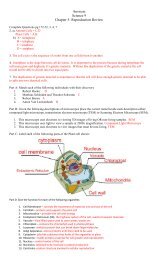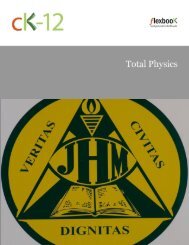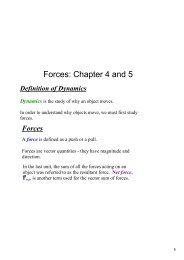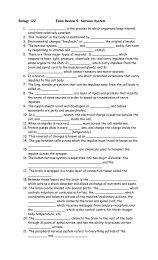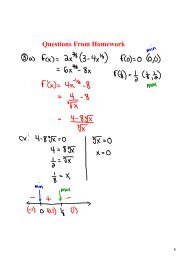Physics Study Guides.pdf - James M. Hill Memorial High School
Physics Study Guides.pdf - James M. Hill Memorial High School
Physics Study Guides.pdf - James M. Hill Memorial High School
You also want an ePaper? Increase the reach of your titles
YUMPU automatically turns print PDFs into web optimized ePapers that Google loves.
MotionBig Picture<strong>Study</strong> <strong>Guides</strong>Everything is in motion. For example, we are all moving around the sun. This means that when we talk about motion,we must look at it relative to something else. The motion of objects through space is one of the first subjects of studyfor early physicists, but it took a very long time before motion was fully understood. To describe motion, we use ratessuch a velocity, speed, and acceleration. Throughout this study guide, assume negligible air resistance.<strong>Physics</strong>Disclaimer:Key TermsDisplacement: The distance an object has moved from its starting position. SI units: mSpeed: The rate at which an object covers distance (distance/time). SI units: m/sVelocity: Speed in a given direction. SI units: m/sAcceleration: The rate at which an object’s velocity is changing (velocity/time). Like velocity, acceleration is a vector.SI units: m/s 2Projectile Motion: The non-linear path an object takes when moving under the constant acceleration of gravity.Free Fall: Objects falling due to gravity only. Example: an apple falling from a tree is in free fall.Describing Ions MotionDisplacement vs. DistanceDisplacement and distance both measure a changein position. Displacement is a vector quantity, whiledistance is a scalar.If an object moves in one direction and then returns toits original position, the total distance will be a positivenumber and the total displacement will be 0. Thediagram below illustrate the concept of displacement.AccelerationUsually we use “acceleration” to mean speeding upand “deceleration” to mean slowing down. In physics,acceleration is a vector quantity that could refer tospeeding up, slowing down, or even changing direction.Careful: positive acceleration does not alwaysmean speeding up and negative accelerationdoes not always means slowing down.Think of an acceleration as a push. We can definepositive acceleration as a push to the right and negativeacceleration as a push to the left.If an object has a negative velocity, meaning that theobject is moving towards the left, then a positiveacceleration pushing the object to the right will cause theobject to slow down.• If the velocity and acceleration are in the same direction,the object speeds up. If not, the object slowsdown.Speed vs. VelocitySpeed is a scalar quantity that measures how fast anobject is moving. In comparison, velocity is a vectorquantity. Velocity is speed with a direction. Objectsmoving at the same speed can have different velocitiesif they are moving in different directions.Instantaneous vs. AverageThere are two types of speed, velocity, and acceleration:instantaneous and average.Instantaneous refers to a single moment in time, whileaverage refers to over a period of time.For example, we can say a car is moving at the speed of25 mph, but if we say the car is moving at 25 mph to thenorth, then we are stating its velocity.NotesThis guide was created by Christopher Addiego and Catherine Wu. To learnmore about the student authors, visit http://www.ck12.org/about/about-us/team/interns.Page 1 of 4v1.1.10.2012this study guide was not created to replaceyour textbook and is for classroom or individual use only.




